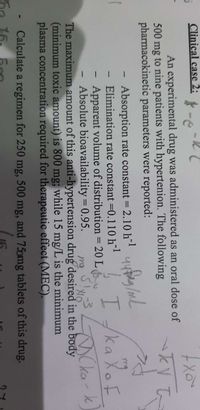Question

Transcribed Image Text:Clinical case 2: -e
An experimental drug was administered as an oral dose of
500 mg to nine patients with hypertenion. The following
pharmacokinetic parameters were reported:
Absorption rate constant = 2.10 h* yu/mL
Elimination rate constant =0.110 h
Apparent volume of distribution = 20 L
Absolute bioavailability = 0.95.
The maximum amount of this anti-hypertension drug desired in the body
(minimum toxic amount) is 800 mg; while 15 mg/L is the minimum
plasma concentration required for therapeutic effect (MEC).
I/ka Xof
OCka-k
Calculate a regimen for 250 mg, 500 mg, and 75omg tablets of this drug.
Expert Solution
This question has been solved!
Explore an expertly crafted, step-by-step solution for a thorough understanding of key concepts.
This is a popular solution
Trending nowThis is a popular solution!
Step by stepSolved in 2 steps

Knowledge Booster
Similar questions
- iac Lab Report 9. Page 3 of 3 and SV is 70 mL. a. Calculate ESV: b. Calculate EF: C. Based on the given and calculated values, shade in the portion of each vith that represents the volume of blood present and label the shaded area wiu the volume in mL. (Note: The EDV box is always full.) ESV AS After contraction in cardiac contractile cells, some cytosolic calcium is returned to the ECF by Na/Ca secondary active transport carriers in the sarcolemma. Drugs called cardiac glycosides inhibit the sarcolemma Na/K pump. Based on this information, answer these questions about the effects of cardiac glycosides. 000 10. > Cardiac glycosides (increase or decrease?) the Na concentration gradient between the cardiac contractile cell ICF and the ECF. > The change in the Na gradient (increases or decreases?) the activity of the Na/Ca secondary active transport carriers. > As a result, the level of calcium in the cytosol (increases or decreases?). > In the presence of these drugs, the strength of…arrow_forwardFill in the information below for the ekg rhythm strip?arrow_forwardGive nafcillin 250 mg IVPB q4h Available: nafcillin 500 mg powder; add 1.8 ml diluent to yield 2 ml Set and solution: NS 50 ml bag and a buretrol with a drop factor of 60 gtt/ml Instructions: Dilute in 50 ml and infuse over 30 min 1 What is the correct dose? 2. What is the flow rate? 3.What is the drop rate?arrow_forward
- What’s the input and outputarrow_forwardThe preparation instructions for a heparin protocol are outlined below. Prepare solution by adding 30 000 units of heparin into a 500 mL IV bag of D5W. Begin infusion at a rate of 16 units/kg/hr. Your patient weighs 72.3 kg. What is the initial flow rate for this patient? Indicate the quantity and unit of measure where specified. Quantity: Unit:arrow_forwardI need help solving an intravenous therapy calculation from my dimesional analysis workbook. The question says, Order : zosyn 3.375 gm IV q6h Available: zosyn 3.375 gm in 150 mL of NSS to infuse over 30 minutes. Your IV set delivers 20 gtt/mL. How many mL/hr will the IV infuse? ( round to nearest whole number)arrow_forward
arrow_back_ios
arrow_forward_ios